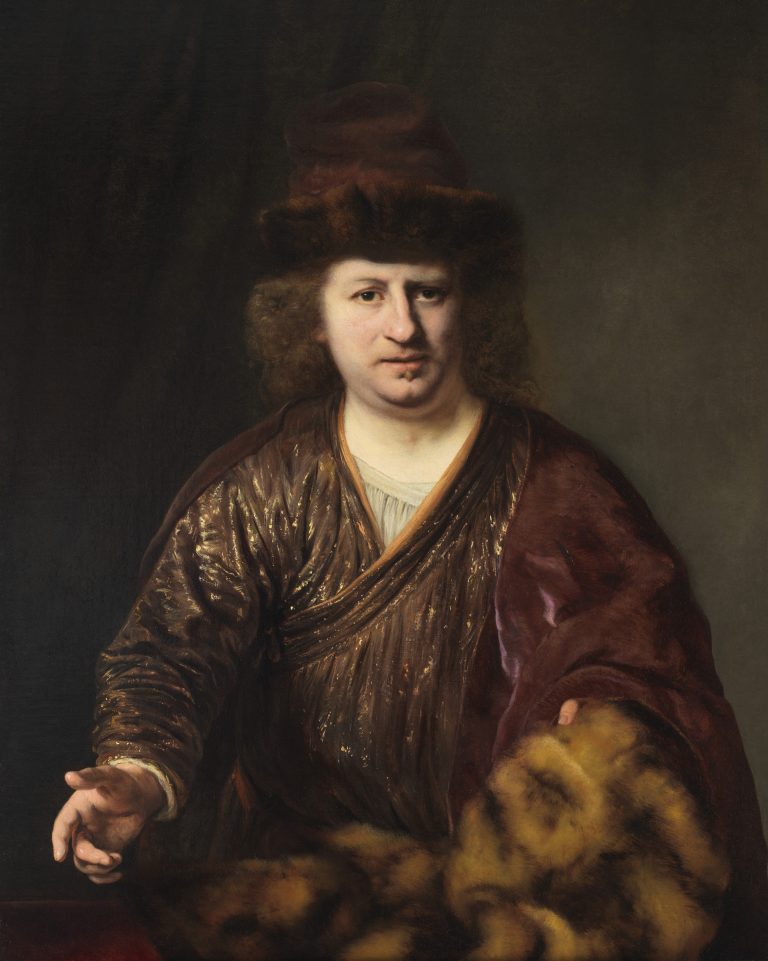Although traditionally considered to be among the last in Ferdinand Bol’s series of character studies, or tronies, executed in the 1640s and 1650s, this three-quarter-length, exotically dressed male figure bespeaks a formal portrait.1 Wearing a fur-trimmed hat and a brown jacket accented by a mustard colored collar and sparkling golden highlights, the man raises his right hand toward the beholder in a rhetorical gesture. In the other he grasps a fur pelt, which nearly spills into the viewer’s space. Speckled black spots, which are softly rendered across the light brown pelt, fall into folds of light and shadow. A deep red cloak—a reoccurring element in Bol’s tronies and self-portraits—hangs down over his left shoulder so that only his thumb is visible beneath it.2 The sitter’s frontal, engaged pose and expectant expression distinguish this composition among Bol’s portraits.3
The figure’s costume combines historicizing and contemporary elements.4 The golden brown jacket and the white shirt beneath it are both diagonally fastened around the man’s torso, which, as Marieke de Winkel has noted, was a style associated with sixteenth-century oriental clothing.5 Fur hats, although a common feature of men’s wardrobes in the seventeenth century, were rarely depicted in portraiture.6 Bol may have been inspired by Rembrandt’s 1631 Portrait of Nicolaes Ruts (fig 1), which represents the wealthy merchant in a similar fur-trimmed hat, along with a fur-trimmed tabbaard.7 Bol’s spotted fur pelt—probably sable—would have likewise been an extremely valuable item. Sable was exclusively imported from Russia, and its representation here, combined with the unusual, oriental-style jacket, is exceptional.8
This inventive costume departs from the type of dress typically worn by sitters in Bol’s portraits, as well as in his tronies and self-portraits. Following the model provided by Rembrandt in works such as his 1640 Self-Portrait at the Age of 34 (fig 2), Bol depicted male figures wearing old-fashioned velvet berets and elegant cloaks, as in his Portrait of a Gentleman (fig 3) and Portrait of a Man in Munich, both dated ca. 1645, and the Leiden Collection’s Man with a Book (FB-100) and Self-Portrait, behind a Parapet (FB-107).9 Although Bol occasionally rendered figures in oriental turbans and helmets, which similarly relied on Rembrandt’s example, there is no indication that these works were commissioned portraits.10 The only other figure that Bol portrayed so prominently in fur was the scholar in his Old Man with a Globe in the Hermitage (fig 4).11 This work, dated to around 1650, shows the elderly man wearing a fur-trimmed hat, a spotted fur-lined cloak, and a golden tunic that resembles the one depicted in Man with a Fur-Trimmed Hat.12
The distinctive character of the Leiden Collection’s portrait broadly reflects Bol’s approach to portraiture in the second half of the 1640s. The painting’s bare, brown background, the artist’s use of chiaroscuro, and the frontal pose of the sitter correspond to works such as the Portrait of a Gentleman (fig 3) and the Munich Portrait of a Man.13 Bol’s treatment of the composition and the posture of the figure, specifically the commanding frontal pose and outstretched hand, are seen in Self-Portrait in Dordrecht from 1646 and Portrait of a Gentleman (fig 3).14 These similarities suggest that Bol executed the Leiden Collection work during these same years, ca. 1646–48.15 A date in the mid- to late 1640s more closely situates the painting in the period following Bol’s training in Rembrandt’s workshop, reinforcing the probability that the master’s Portrait of Nicolaes Ruts (fig 1) served as the model for this work.16 Although the identity of Bol’s sitter is unknown, the prominent display of fur in this portrait bolsters the argument that he was also involved in the fur trade.17
